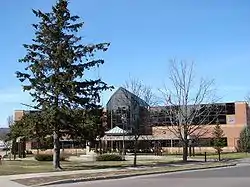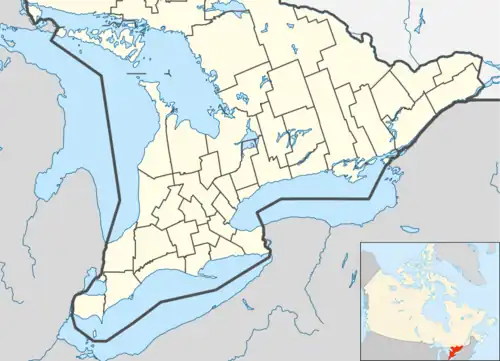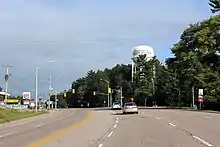Deep River | |
|---|---|
| Town of Deep River | |
 Town Hall in Deep River | |
| Nickname: Canada's Nuclear Pioneers | |
 Deep River  Deep River | |
| Coordinates: 46°06′N 77°29.5′W / 46.100°N 77.4917°W | |
| Country | |
| Province | |
| County | Renfrew |
| Founded | 1944 |
| Government | |
| • Mayor | Suzanne D'Eon |
| • Federal riding | (federal electoral district)|Renfrew—Nipissing—Pembroke |
| • Prov. riding | (provincial electoral district)|Renfrew—Nipissing—Pembroke |
| Area | |
| • Land | 50.13 km2 (19.36 sq mi) |
| Population (2016)[1] | |
| • Total | 4,109 |
| • Density | 82.0/km2 (212/sq mi) |
| Time zone | UTC-5 (Eastern Standard Time (EST)) |
| • Summer (DST) | UTC-4 (Eastern Daylight Time (EDT)) |
| Postal code | K0J 1P0 |
| Area code | 613 |
| Website | www.deepriver.ca |
Deep River is a town in Renfrew County, Ontario, Canada. Located along the Ottawa River, it lies about 200 kilometres (120 mi) north-west of Ottawa on the Trans-Canada Highway. Deep River is opposite the Laurentian Mountains and the Province of Quebec. The name Deep River purportedly derives from the fact that the Ottawa River reaches its greatest depth of 402 feet (123 m) just outside the township. However, the Ottawa River today reaches a depth of 565 feet (172 m) in Moose Bay which is located on the Holden Lake reservoir from the Des Joachim dam, west of Deux-Rivières.
The primary industry centres on research at the Chalk River location of Canadian Nuclear Laboratories (CNL), a facility of the Chalk River Laboratories about 10 km east of Deep River on Highway 17. The facility is named for, and primarily accessed via, the nearby town Chalk River, although the site is technically in Deep River.
History

Plans for the construction of this planned community began in 1944 by the federal government as part of the Manhattan Project, to accommodate employees of the nearby Chalk River Nuclear Laboratories (CRNL). Along with Los Alamos, New Mexico and Oak Ridge, Tennessee, Chalk River was an offshoot of the nuclear effort for the allies and scientists, engineers, and tradesmen from around the world who came to work on the Manhattan Project. After World War II, Canada continued on with research into the atom, and dedicated the country to the peaceful uses that could be derived from putting the atom to use. Deep River was situated far enough upwind and upriver of the Chalk River research reactors to avoid radioactive fallout.
John Bland, an architecture professor at McGill University, developed the town's first master plan in 1944. Bland located the town between the existing Highway 17 and the Ottawa River. He designed a system of streets which generally followed the contours of the area's topography. Residential neighborhoods stretched out from a commercial and service-sector core. Straight and broad avenues ran along contour lines, while narrower and winding streets lay at right angles, discouraging non-local traffic from entering neighborhoods. Parks and schools were located strategically throughout the town. The streets were named after local flora, Canadian politicians and famous scientists such as Ernest Rutherford and Charles Darwin.[2]
At the same time, its economy and development was further boosted by the construction of the Des Joachim Hydroelectric Generating Station and dam on the Ottawa River at Rolphton, which opened on June 28, 1950.[3]
The town was the subject of a Maclean's Magazine article in 1958 by the noted Canadian journalist, editor, and author Peter C. Newman. Entitled, "Deep River: Almost the Perfect Place to Live,"[4] the article took a sardonic take on the town as a very odd and isolated place populated by mostly young, male, highly educated and bored scientists and technicians struggling to find things to do with their time: "The Utopian town where our atomic scientists live and play has no crime, no slums, no unemployment and few mothers-in-law."
In 1962, the experimental Nuclear Power Demonstration or NPD power reactor started up as a prototype for later CANDU reactors. This was operated by Ontario Hydro, which later used it as a training facility for new employees in their Nuclear division. This brought many more temporary residents to the town. The NPD was shutdown in 1987; the nuclear fuel was removed from the site, along with non-radioactive equipment, leaving only the building shell and the nuclear components (reactor, tanks, pipes etc.) that had become radioactive in place to wait for further decommissioning. The facility has been waiting for final demolition and permanent disposal of the radioactive nuclear components for over 30 years.[5]
Geography

Deep River is located at a latitude of 46°06' north and longitude 77°30' west, in the Boreal Forest biozone, and has an area of 50.87 square kilometres. The town sits on the section of the Ottawa River referred to as "La Rivière Creuse" (the "Deep River") by 17th-century French explorers, and which later was at the heart of Canada's 19th-century timber trade.
Recreation, arts and culture
Deep River boasts many active clubs.[6] Among the numerous community accomplishments is the creation of the Deep River Symphony Orchestra, formed in 1951, making Deep River one of the smallest towns to have a symphony orchestra. The Deep River Choral Group, and Deep River Community Band also host multiple concerts every year. Cross-country skiing is a popular winter recreation. Avid skiers of the Deep River Cross-Country Ski Club[7] created the Silver Spoon trails and an annual race that brings contestants from across Ontario. Another popular event is Summerfest, a festival held once every two years, hosting many local and famous artists including Sloan, Wide Mouth Mason, Amanda Wilkinson, Daniel Lanois, Mobile, and K'naan. The festival also organizes many recreational events, including the Cross-River Swim.
Deep River is generally known to have picturesque scenery, excellent boating along the broad river, and good hiking in the hills across the Ottawa River. Deep River also has a community pool, fire department, police department, ski hill, golf course, curling rink, yacht and tennis club, and a library.
Deep River is home to two museums: The Canadian Clock Museum, home to an extensive collection of clocks from The Arthur Pequegnat Clock Company, and the Society for the Preservation of Canada's Nuclear Heritage, founded in 2017, which collects, safeguards, and promotes documents, artifacts, memorabilia, and knowledge associated with the history of the Canadian nuclear industry.
Demographics
In the 2021 Census of Population conducted by Statistics Canada, Deep River had a population of 4,175 living in 1,866 of its 1,981 total private dwellings, a change of 1.6% from its 2016 population of 4,109. With a land area of 50.27 km2 (19.41 sq mi), it had a population density of 83.1/km2 (215.1/sq mi) in 2021.[8]
| 2021 | 2016 | 2011 | |
|---|---|---|---|
| Population | 4,175 (+1.6% from 2016) | 4109 (-2.0% from 2011) | 4193 (-0.5% from 2006) |
| Land area | 50.27 km2 (19.41 sq mi) | 50.13 km2 (19.36 sq mi) | 50.90 km2 (19.65 sq mi) |
| Population density | 83/km2 (210/sq mi) | 82.0/km2 (212/sq mi) | 82.4/km2 (213/sq mi) |
| Median age | 47.6 (M: 46.0, F: 49.2) | 47.6 (M: 46.6, F: 49.1) | |
| Private dwellings | 1,981 (total) 1,866 (occupied) | 1825 (total) | 1933 (total) |
| Median household income | $95,000 |
Education
Deep River was last home to four schools in 2005, for students from Junior Kindergarten through Grade 12:
- T.W. Morison Public School - now closed, it used to be for students JK to grade 6. As decided by the school board on October 26, 2009, Morison Public School was closed down and moved into Mackenzie High School for the 2011-2012 school year in favour of making Mackenzie a JK-12 "education centre."
- Keys Public School - now closed, it used to house students grade 5 to grade 8. At the end of the 2004-2005 school year, Keys Public School was officially closed down due to budget cuts in the school board. The Junior half of Keys (grades 5 and 6) was moved to Morison Public School, and the Intermediate half (grades 7 and 8) joined Mackenzie, separated by name only (though Mackenzie students are not allowed in the Keys Wing). It was predicted Morison would close down at the end of the 2006-2007 school year (for same above mentioned reasons) and would join Mackenzie High School as well, but was delayed in a decision to close until October 2009. In 2011, with the creation of Mackenzie Community School, Keys ceased to exist; it was named for nuclear scientist David A. Keys. The Keys Public School building was rented by AECL (Atomic Energy Canada Limited) for use as an office building. There have since been small changes to the building such as new fences, change in parking, security cameras and codes and badge scanners for doors.
- Mackenzie High School - for students grades 9 to 12 (building now houses Keys Public School). Ceased to exist as of 2011 in name; amalgamated with Keys Public School and T.W. Morison Public School to create Mackenzie Community School. It was originally named for C. J. Mackenzie, who served as head of Canada's National Research Council.
- Mackenzie Community School[14] - for students JK to grade 12. Created in 2011 after the amalgamation of T.W. Morison Public School, Keys Public School, and Mackenzie High School; the school is housed in the previously named Mackenzie High School building. All sports team adopted the colours (Purple and Gold) and mascot (Mustangs) of Mackenzie High School. The school building also houses and hosts numerous community groups and activities.
- St. Mary's Catholic School[15] - for students JK to grade 8
The Deep River Summer Music Camp[16] attracts around 100 students for a two week day-camp every summer.
The Deep River Science Academy hosted university and high-school students in creating numerous science projects in cooperation with many of the knowledge-economy enterprises of the area. The Academy ceased operations in 2016.[17]
Media
Deep River's weekly, The North Renfrew Times,[18] has been published by the Deep River Community Association[19] since the Town's earliest days.
Radio
Deep River is served by a low-power FM repeater of Ottawa's CBC Radio station, CBO-FM:
- 97.9 FM - CBCD-1, CBC Radio One
All other stations that may be heard in Deep River broadcast from Pembroke, Ontario. See radio stations in the Ottawa Valley Region and Quebec.
Screen
Deep River has achieved a degree of notoriety in the films of David Lynch. As well as being referenced in Blue Velvet, the town is specifically mentioned in Mulholland Drive, Lynch's surreal film about a young actress struggling to cope in Hollywood. Naomi Watts plays a character named Betty at the beginning of the film.
Betty: "I just came here from Deep River, Ontario, and now I'm in this ... dream place. You can imagine how I feel."
Notable people
- Jack Gray - 40th Grey Cup Champion with the Toronto Argonauts[20]
- Derek Harvie - TV and film writer and producer
- Russell Williams, English-born Canadian serial killer and rapist, lived most of his childhood in Deep River after he and his family emigrated to Canada.[21]
See also
Notes
- 1 2 Statistics Canada 2011 Census - Deep River Census Profile
- ↑ Melvin, Joan. 1995. Deep River: A Pictorial History - 1945 to 1995. DFR Printing, Pembroke, Ontario.
- ↑ Ontario Power Generation: Des Joachim Hydroelectric Station Archived 2012-03-24 at the Wayback Machine, accessed: 2008-02-24
- ↑ Peter C. Newman (1958-09-15). "Deep River: Almost the Perfect Place to Live". Maclean's. Archived from the original on 2007-09-29.
- ↑ "Nuclear Power Demonstration Closure Project".
- ↑ Deep River Community Association. "DRCA Member Clubs". Archived from the original on 2005-04-07.
- ↑ Town of Deep River. "Deep River Cross-Country Ski Club". Archived from the original on 2008-03-12.
- ↑ "Population and dwelling counts: Canada, provinces and territories, census divisions and census subdivisions (municipalities), Ontario". Statistics Canada. February 9, 2022. Retrieved March 30, 2022.
- ↑ "2021 Community Profiles". 2021 Canadian Census. Statistics Canada. February 4, 2022. Retrieved 2023-10-19.
- ↑ "2016 Community Profiles". 2016 Canadian Census. Statistics Canada. August 12, 2021.
- ↑ "2011 Community Profiles". 2011 Canadian Census. Statistics Canada. March 21, 2019. Retrieved 2012-02-13.
- ↑ "2006 Community Profiles". 2006 Canadian Census. Statistics Canada. August 20, 2019.
- ↑ "2001 Community Profiles". 2001 Canadian Census. Statistics Canada. July 18, 2021.
- ↑ "Mackenzie Community School". Renfrew County District School Board. Retrieved January 30, 2020.
- ↑ "St. Mary's (Deep River)". Renfrew County Catholic District School Board. Retrieved January 30, 2020.
- ↑ "Deep River Summer Music Camp". 4 February 2013. Retrieved 23 May 2020.
- ↑ "Drsa Deep River on Facebook". Facebook. Archived from the original on 2022-04-27.
- ↑ "The North Renfrew Times website". northrenfrewtimes.ca. Retrieved 8 November 2023.
- ↑ "The Deep River Community Association". Archived from the original on 2005-02-12. Retrieved 2005-04-09.
- ↑ "RIP Jack Gray". North Renfrew Times. 11 April 2018. Retrieved 1 October 2020.
- ↑ "PressReader.com - Digital Newspaper & Magazine Subscriptions". www.pressreader.com. Retrieved 8 November 2023.
